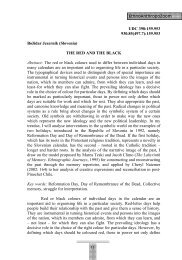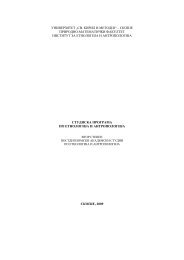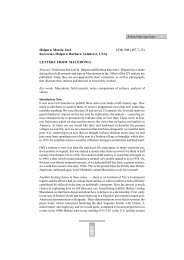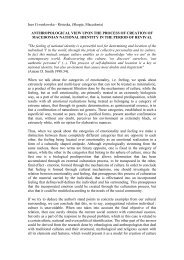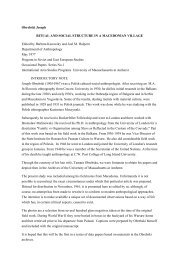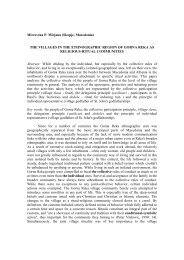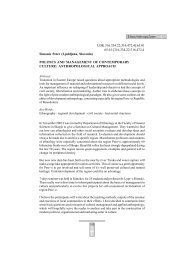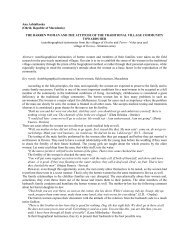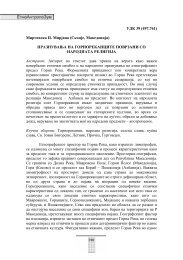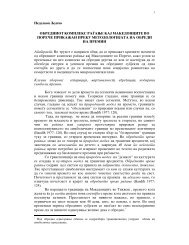KABUKI
KABUKI
KABUKI
Create successful ePaper yourself
Turn your PDF publications into a flip-book with our unique Google optimized e-Paper software.
Anna Kurpiel,<br />
<strong>KABUKI</strong><br />
THE CLASSICAL JAPANESE THEATRE<br />
Japanese classical theatre contains few forms of performances – Noh, Kyogen - lyrical<br />
drama, Bunraku - puppet theater and Kabuki – which is the popular theatrical form.<br />
There are two ways to interpret sources of the word “Kabuki”. First, the simpler one<br />
says, that this name comes from three words: ka – which means singing, bu = dancing, ki =<br />
acting. It’s supposed to be truth, because Kabuki as a performance contains all of this<br />
elements. But this word is also believed to derive from the verb kabuku, meaning to lean or to<br />
be out of the ordinary. So Kabuki can be in the other way interpreted to mean avant-garde or<br />
bizarre theatre. The justification to this second theory we can find in the book of Masakatsa<br />
Gunji -“Kabuki” 1 . Due to the author’s words, there exist one unique aesthetic concept of<br />
Kabuki theatre, which is giving it consistency – the concept of yatsusi. The autor gives a<br />
definition: “Yatsushi is basically an attempt to modernize everything, to transfer it into terms<br />
of contemporary society, to parody the old by recreating it in terms of the present and<br />
familiar”. To follow this rule, we can say that Kabuki is no more that the yatsusi of Noh and<br />
Kyogen ( in the same way haiku – the short lyric forms - are yatsusi of the classical waka<br />
verse poem.)<br />
History<br />
The oldest Japanese form of classical theatre is Noh. First printed texts date from<br />
about 1600 year, but the language in which they were written came from XIV century and it’s<br />
already mature, that is why there are supposed to be much older.<br />
Kabuki and Burnaku are younger art-forms, established by the time the centre of<br />
power had shifted to the east with the setting up of the Togunawa Shogunate (laste until the<br />
restoration in 1868) at Edo (modern Tokyo), at the beginning of XVII century. They reached<br />
their highest point of development in the 2 half of the century, and remained more or less<br />
static for some time. Since 1945 the many small Kabuki troupes which used to tour the<br />
countryside have been disbanded and performances have been given only in larger city.<br />
Kabuki performers during the earliest years of the genre were primarily women. This<br />
theatrical form is thought to have originated in the dances and light theater first performed in<br />
Kyoto in 1603 by Okuni, a female attendant at the Izumo shrine. Because an important side<br />
business of the onna (women's Kabuki troupes) was prostitution, the Tokugawa shogunate<br />
disapproved, banning the troupes in 1629 and making it illegal for women to appear on stage.<br />
Wakashu (young men's Kabuki) then became popular, but in 1652 it was also banned because<br />
of the adverse effect on public morals of the prostitution activities of the adolescent male<br />
actors.<br />
With both women and boys banned, Kabuki became a theater of mature male<br />
performers, although before yaro (men's Kabuki) was permitted to continue performing, the<br />
government required that the actors avoid sensual displays and follow the more realistic<br />
conventions of the Kyogen Theater.<br />
Perhaps the most famous aspect of Kabuki is its use of onnagata, male actors in<br />
female roles. The ideal for the onnagata is not to imitate women but to symbolically express<br />
the essence of the feminine. In the century following the legal mandating of male performers<br />
1 Masakatsu Gunji, Kabuki, printed in Japan, p.16<br />
1
onnogata roles became increasingly sophisticated. Attempts to introduce actresses into<br />
Kabuki in the modern era have failed. The onnagata are such an integral part of the Kabuki<br />
tradition that their replacement by actresses is extremely unlikely.<br />
Kabuki is not only the theatre<br />
Kabuki, like all of Japanese classical forms of art is really hight-developped and<br />
organized till the last detail. However, even though it is like one unseparable organism, every<br />
of various element of Kabuki play, such as music, decoration, costiums, maight be a total art<br />
form, due to the fact that like Kabuki itself, they reached high point of profesionalism. All of<br />
them follow their own, unique rules.<br />
“Models of theatrical expression are much more varied and diverse in Kabuki than in<br />
Noh and Kyogen. “ – writes Kawatake Toshio 2 and he gives the reason for this – because of<br />
the long – four-hundred year history. Since the time when Izumo no Okuni created kabuki<br />
odori in 1603, Kabuki has continued to grow and evolve freely, even willfully, as the<br />
entertiment of ordinary people.<br />
The same opinion shares Masakatsu Gunji, which writes about Kabuki theatre that its<br />
beauty “is too complex and comprises too many different elements to be easly summerised”. 3<br />
Kabuki as a family – the Kabuki actors<br />
While acting techniques must depend on individual actors to give them life, Kabuki is<br />
characterized by certain styles or pattern of acting, known in Japanese as “kata”. The mastery<br />
of these required a great deal of training and thay are handed down in families of actors from<br />
generation to generation.<br />
A family tradition of acting may depend on blood relationship, or more often, on<br />
artistic kinship. It’s the ability, which is the criterion by which a good artist chooses his<br />
successor. Generally, this type of system is characteristic of all classical performing arts of<br />
Japan. However, with Kabuki (as well as with Burnaku ) the technical aspect, the fact that one<br />
man posses his experience on a single successor is more important that close spiritual contact.<br />
The ceremony at which an actor takes over the name of an illustrious elder is primary a sign<br />
that he is caring on the acting traditions of the family, that is important rather than individual.<br />
For this some reason, there has always been a strong code of ethics among actors, that<br />
governs they behavior as artist and their obligations to the family or school to which they<br />
belong. To succeed on actor means to take over his art in the name of his family, the sign of<br />
the tradition being the kata that the younger actors inherit from him.<br />
Each acting family has a specific style and approach to each role. The most famous of<br />
the Kabuki family lines is that currently headed by Ichikawa Danjuro XII (born in 1946). An<br />
actor who inherits the Ichikawa Danjuro name must not only master his predecessors'<br />
approach to a role but also add his own individual nuances. Other important family lines<br />
include those headed by Onoe Kikugoro VII (b. 1942) and Nakamura Utaemon VI (born in<br />
1917).<br />
Elements of Kabuki – stage, costumes, music<br />
Due to all theatrologycal theories, there are three factors which are indispensable for<br />
theatre – plays, actors and audience. But Kawatake Toshio adds the fourth element – the<br />
stage. There exist in Japan few kinds of stage – bugakuden or gagakuden – special for Bugaku<br />
dance or Gagaku music, the Noh stage and the respective stages for Kabuki and the puppet<br />
theatre - Burnaku. This type of stage sprang up among the ordinary people of Togunawa<br />
2 Kawatake Toshio, Kabuki, 2001, Tokyo, p.34<br />
3 Masakatsu Gunji, Kabuki, printed in Japan, p.15<br />
2
shogunate and developed, like all things of classical Japan, into mature and very conventional<br />
form.<br />
One of the most recognisable elements of Kabuki stage is “hana-michi” (= “flower<br />
way”), which is running on the left-hand side from the back of the hall to the stage at the level<br />
of spectators’ heads. It’s the entrance and exit for characters, but because of actors<br />
sophisticated unexpectable it also can seem to be something like stage “trick”. A number of<br />
stage tricks, including rapid appearances and disappearances of actors, have evolved using<br />
these innovations. The term “keren”, often translated playing to the gallery, is sometimes used<br />
as a catch-all term for these tricks.<br />
One other of popular keren is the Chūnori (riding in mid-air) - a technique, which<br />
appeared toward the middle of the nineteenth century, by which an actor’s costume is attached<br />
to wires and he is made to “fly” over the stage and/or certain parts of the auditorium. This is<br />
similar to “wire fu” of modern cinema. As these “tricks” (keren) devices have fallen out of<br />
favor many stages are no longer equipped to handle them.<br />
But the Kabuki stage is not only a place for making kerens, but it’s a space which is<br />
following some rules, making it the unique area, easy-to-read for people who know the<br />
Japanese tradition. What’s interesting, the curtain not rise but roles back one side. All the<br />
scenery is elaborate and complete to the last detail, but also sipmlified almost to astetism.<br />
There are few types of Kabuki stage. One of them is “Mawari-butai” (“revolving<br />
stage”) developed in the Kyōhō era (1716-1735). Originally accomplished by the on-stage<br />
pushing of a round, wheeled platform this technique evolved into a circle being cut into the<br />
stage floor with wheels beneath it facilitating movement. When the stage lights are lowered<br />
during this transition it is known as kuraten (“darkened revolve”). More commonly the lights<br />
are left on for akaten (“lighted revolve”), sometimes with the transitioning scenes being<br />
performed simultaneously for dramatic effect.<br />
The other type of Kabuki stage might be the “Seri” refers to the stage traps that have<br />
been commonly employed in Kabuki since the middle of the eighteenth century. These traps<br />
raise and lower actors or sets to the stage. Seridashi or seriage refers to the traps moving<br />
upward and serisage or serioroshi when they are being lowered. This technique is often used<br />
for dramatic effect of having an entire scene rise up to appear onstage.<br />
But maybe the most interesting thing is that in Japanese theatre acting and play<br />
production, including music, are closely allied to the structure and the function of the stage<br />
and theatre building. The same is in Kabuki. And what’s more, all these elements have been<br />
passed down as a whole from one generation to the next, as thought a single living organism.<br />
Not only the performance, but also a structure of the stage – as a place for this performance -<br />
differentiates all kind of Japanese theatre and makes Noh to be Noh and Kabuki to be Kabuki<br />
and nothing else. This is also the difference between European performance – which can be<br />
played in every kind of stages, also in open air, and Japanese ones, which need to follow strict<br />
rules simply to exist and be understandable for the people.<br />
While the stage is completely connected with the type of the classical theatre, the<br />
costumes are similarly fitted to the part. Rich boarded silks are use in the historical subjects<br />
dramas, plain - where the scenes are drown from common life.<br />
Actors in Kabuki theatre are heavily made-up in conventional style, appropriate to the<br />
character represented. Keshō, Kabuki makeup, provides an element of style easily<br />
recognizable even by those unfamiliar with the art form. Rice powder is used to create the<br />
white oshiroi base, and kumadori enhances or exaggerates facial lines to produce dramatic<br />
animal or supernatural masks for the actors. The color of the kumadori is an expression of the<br />
character's nature: red lines are used to indicate passion, heroism, righteousness, and other<br />
positive traits; blue or black, villainy, jealousy, and other negative traits; green, the<br />
supernatural; and purple, nobility.<br />
3
Music and sound effects in Kabuki stage are provided by a small party of<br />
instrumentalists inconspicuously placed behind a lattice on the left of the stage. By far the<br />
most important instrument used in Kabuki is the three-stringed shamisen. Included in the<br />
musical genres that are performed on stage in view of the audience are the nagauta (long<br />
song) style of lyrical music and several types of narrative music in which a singer or chanter<br />
is accompanied by one or more shamisen and sometimes other instruments. The standard<br />
nagauta ensemble includes several shamisen players as well as singers plus drum and flute<br />
players.<br />
In addition to the onstage music, singers and musicians playing the shamisen, flute and<br />
a variety of percussion instruments are also located offstage. They provide various types of<br />
background music and sound effects. one of the special type of sound effect found in Kabuki<br />
is the dramatic crack of two wooden blocks (hyoshigi) struck together or against a wooden<br />
board.<br />
Performances and plays<br />
As it was said in the beggining, firs Kabuki performances, played by femail bands,<br />
were mostly focused on a dance. Kabuki dance was originally classified as odori (there are<br />
two types of traditional Japanese dances: mai – generally distinguished by a restrained,<br />
ceremonial quality, and odori – which literally means “jumping”, characterized by a more<br />
earthy, extroverted type of movement.), it drew on the nenbutsu odori and used popular songs<br />
for accompaniament.<br />
The term nihon buyo, or Japanese classical dance, generally refers to Kabuki dance<br />
and its derivatives, as distinct from the ancient and medieval genres. Today there are upwards<br />
of 150 schools of classical dance that transmit from generation to generation the artistic styles<br />
of accompanished Kabuki actors and dancers.<br />
By the time, however, dance gave a way to drama as the most improtant aspect of<br />
Kabuki, and professional playwrights began to appear on the scene, the leading light among<br />
them being Chikamatsu Monzaemon. In the XVIII century puppet theater plays like<br />
Kanadehon Chűshingua were adapted for Kabuki, and the theatres specially designed for<br />
Kabuki began to take shape and many other dramatic works were written specifically for<br />
Kabuki. There are around four hundred that can still be performed today, including the socalled<br />
“neo-Kabuki” plays written since the Meiji period. Of these 41% are pure Kabuki<br />
plays, 27% are gidayu kyogen, 21 dances, and 11% date to the late XIX century or later.<br />
Among classical Kabuki plays we can recognizes 3 main classes: first - jidaimono –<br />
which are the histories with a subdivision composed of scenes of exaggerated action, second –<br />
sewamono, which could be translated as domestic melodramas or plays, and the last one:<br />
shosagoto - dance pieces.<br />
A typical program would thus consist a selection of scenes from one of scenes from on<br />
the histories followed by a dance, and a second half consisting by a melodrama follows by<br />
another dance.<br />
Although historical plays – jidaimono - were often about contemporary incidents<br />
involving the samurai class, the events were disguised, if only slightly, and set in an era prior<br />
to the Edo period in order to avoid conflict with Tokugawa government censors. An example<br />
of this is the famous play Kanadehon Chushingura, which told the story of the 47 ronin<br />
(masterless samurai) incident of 1701–1703, but which was set in the early Muromachi period<br />
(1333–1568).<br />
The domestic plays – sewamoto - were more realistic than historical plays, both in<br />
their dialogue and costumes. For audiences, a newly written domestic play may have seemed<br />
almost like a news report since it often concerned a scandal, murder or suicide which had just<br />
occurred. A later variant of the domestic play was the kizewa-mono ("bare" domestic play),<br />
4
which became popular in the early nineteenth century. These plays were known for their<br />
realistic portrayal of the lower fringes of society but they tended toward sensationalism, using<br />
violence and shocking subjects along with elaborate stage tricks to draw in an increasingly<br />
jaded audience.<br />
Dance pieces, such as Kyo-ganoko musume Dojoji (The Dancing Girl at the Temple),<br />
have often served as a showcase for the talents of top onnagata.<br />
Meeting West<br />
The XIX century brought many changes to Kabuki theatre. It was closely connected<br />
with fall of Togunawa shogunat in 1868 and begun of the new Meiji Emperor government.<br />
The samurai class was eliminated and Japan opened to the west. 1872 was the starting points<br />
of changing in Japanese culture, under the motto “civilization and enlightenment”. The<br />
government wanted to make the theatre useful for education purpose, so in practise it meant<br />
historically accurate plays and the censorship. What’s more, actors started to be the members<br />
of the “teaching professions”.<br />
That’s why the Meiji government made the radical reforms in the construction,<br />
organization and function of the Kabuki theatre, such as: expansion of the theatre’s frontage<br />
and depth by around 7,25 meters, improvements to the entrance, installation of seating for<br />
foreigners and installation of gaslights. All theses to be more closed to the West world.<br />
But meeting West meant also deep changes in Japanese mentality. After so many years<br />
of isolation and strictly following old rules and traditions, Japan stood suddenly in the front of<br />
totally strange culture and the other way of thinking. Traditional theatre couldn’t manage the<br />
confrontation with West, European plays. In XIX century first Japanese directors were trying<br />
to perform plays of Shakespeare or Ibsen, but they didn’t succeed. The big tradition, actors<br />
played all the time in the same, conventional way, problem with space, with understanding the<br />
European lifestyle – these made it impossible. Finally all it led to create new, modern<br />
theatrical art – called shingeki, what means “modern drama”. But shingeki is only little<br />
connected with Kabuki, and in XX century it developed in different, modern way.<br />
The confrontation with West is visible also in the vocabulary. Maybe nobody in<br />
modern, XIX- century Japan know, that the words “geki” and “engeki”, which are nowadays<br />
used as “drama” and “theatre” came to Japanese language after the time of isolation. Before,<br />
there existed two different terms: “shibai”- what means “play or dramatic performance” and<br />
“gijõ” which was referred to theatre as a place or a building. Shibai divided into sad ones – it<br />
could be translated as a tragedy, and funny – equivalent to comedies.<br />
But what does this change mean? The word “geki” (this new description of “drama”) consists<br />
three components:” tiger”, “wild boar” and “sword”. All of this things have some connection<br />
with something sharp (for example tiger’s claws) and could be interpretated in relation to<br />
“fighting to the end” (due to Kawatake Toshio’s words, Kabuki, 2001, Tokyo). It reminds<br />
western way of thinking and building the theatrical plot in plays, where the action is<br />
developing during the performance to reach the highest point at the end. A dramatic situation<br />
may exist, of course, in all traditional theatres of Japan (also in Kabuki), but Japanese theatre<br />
exists on a different plane from plays that rely solely on words and gestures, instead, it makes<br />
full use of a wide variety of aural and visual means, that include music and sometimes even<br />
engages the audience directly to create a “theatrical time and space”.<br />
Kabuki now and abroad<br />
However, in contrast to the other forms of classical theater, today Kabuki still<br />
continues to be very popular, regularly playing to enthusiastic audiences at theaters such as<br />
Tokyo's Kabukiza, Kyoto's Minamiza and Osaka's Shochikuza. In recent years new play and<br />
productions have been performanced, and Kabuki’s popularity had spread overeats. In 1990<br />
5
Kabuki performances took place in several countries outside Japan: France, Germany, Hong<br />
Kong, the Philippines, Singapore, Taiwan, and the Unites States.<br />
The first Kabuki performance in a foreign county took place in 1928, in Soviet Union,<br />
in the anniversaty of Russian Revolution. After that, few performances were given in<br />
America, all the time with so big popularity. How we can explain this phenomenon?<br />
According to Kawatake Toshio’s words, Kabuki is simply the most understandable form of<br />
Japanese theater, as it has still some action (in opposition to Noh or Kyogen, which are more<br />
focused on the form of performance, not in the plot). Few Kabuki plays were adapted to<br />
Western people tastes.<br />
With the time, Kabuki started to be one of the easy recognized symbol of Japanese<br />
culture and one of the tourist attraction. It’s now a vigorous and integral part of the<br />
entertainment industry in Japan. The star actors of Kabuki are some of Japanese most famous<br />
celebrities, appearing frequently in both traditional and modern roles on television and in<br />
movies and plays. For example, the famous onnagata Bando Tamasaburo V (born in 1950)<br />
has acted in many non-Kabuki plays and movies, almost always in female roles, and he has<br />
also directed several movies. In 1998 the shumei (name-assuming) ceremony, in which actor<br />
Kataoka Takao (born in 1944) received the prestigious stage name Kataoka Nizaemon XV,<br />
was treated as a major media event in Japan.<br />
Kabuki is a chimera<br />
However, there’s now the question – is the modern, nowadays Kabuki still the same<br />
art as it used to be in its first form, before the confrontation with the philosophy of the West?<br />
One of the Japanese writer said : “Kabuki might be called the “chimera” of the art world.”<br />
Chimera is the three-heads monster, making by parts of different animals. Kabuki, due to<br />
Tsubouchi Shoyo “is constituted just like this.” (Tsubouchi Shoyo and Yamamoto Jiro,<br />
History and Characteristic of Kabuki the Japanese Classical Drama, Yokohama, 1960, p.115).<br />
Now, Kabuki, is not only the chimera of Japanese theatre, but also the chimera of Japanese<br />
culture, witch has developed and changing many times.<br />
6
Bibliography:<br />
Books:<br />
• Masakatsu Gunji, Kabuki, printed in Japan<br />
• Kawatake Toshio, Kabuki, 2001, Tokyo<br />
• Sources of Japanese Tradition, edited by W.m. Theodore de Bary, New York, 1967,<br />
vol 1.<br />
• The Japan Today, 1992, Tokyo<br />
• The Oxford Companion to the Theatre, edited by Phillis Hartnoll, 1967<br />
• Tsubouchi Shoyo and Yamamoto Jiro, History and Characteristic of Kabuki the<br />
Japanese Classical Drama, Yokohama, 1960<br />
Internet:<br />
o Wikipedia, wolna encyklopedia "http://pl.wikipedia.org/wiki/Kabuki<br />
o Wikipedia, the free encyclopedia http://en.wikipedia.org/wiki/Kabuki<br />
o WIEM, darmowa encyklopedia<br />
7



